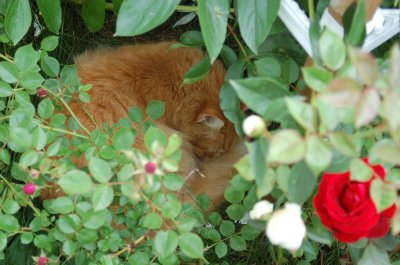
Dave wrote recently about a bobcat's daytime adventure Looking for Water. He speculated on the nature of feline vision:
Drinking from the creek is one thing, but still water must make a wild cat especially cautious. Can't you just see him, catching sight of this other cat in the water and jumping back, then maybe sneaking up on it and touching it with his paw?....The omniscient narrator finds himself unwilling to speculate further. It's all too easy for those of us who see in color to think we know exactly what we're looking at.
Comparative vision studies have always fascinated me. I have a pile of old photocopies of insect vision articles from my grad school days. Since I've been writing for the Web, I've been interested in the way visually impaired people use Web browsers, and the autism/special education gig has taught me about the pairing of visual impairment and autism. Dave set me searching for feline vision references, and I found several interesting things.
- Are cats and dogs really color-blind? How do they know? Just what it says.
- Feline vision--a cat's eye view talks about night vision and visual acuity.
Cats give up the ability to see fine detail and rich colors in exchange for the ability to see in the dark. The level of retina illumination is about five times higher in your cat's eye than in yours. And all those rods pooling signals from minute amounts of light allow the cat to pick up the faintest light source. Nonetheless, some light still manages to pass between the rods and cones. Instead of letting it be absorbed at the back of the eye, as the human eye does, the cat has a structure called the tapetum lucidum that reflects light back to the receptors for a second chance to create a signal. The eye shine you see when you shine a light at a cat in the dark is the reflected light that has managed to elude the receptors in both directions and is bouncing back to you from the tapetum. The end result is that cats can see light at eight times dimmer illumination than you can!
In summary, the cat's eye is specialized to see in dim and changing light. To achieve this it sacrifices the ability to focus close up, detail vision, and some color vision. It is the vision of a hunter active in both day and night, enabling it to detect movement under any lighting conditions, to use binocular vision to gauge distance, and to aim correctly to catch prey.
- Vision In Dogs, Horses, and Cats, a veterinary eye care compares and contrasts vision:
Dogs have cones that are receptive at 429 and 555 nm and are dichromats. All evidence suggests that the dog is dichromat with vision similar to a human who is red-green color blind. Cats are weak trichromats. Feline cones peak at 450, 500 and 555 nm. They live in a world of fuzzy pastels.
Dogs and cats appear to respond to the blue and yellow short-wave length colors the best, but appear to have trouble with green and red. Both are also rod-dominant animals. As rods do not function in daylight these animals are dependent on their few cones for spatial and temporal visual resolution, which probably means that their blue and yellow visual world is a fuzzy blue and yellow world. What appears red to us is simply dark to the dog and cat, and a part of the green spectrum is indistinguishable from white. Colors that would appear very rich to us are more pastel-like to the cat. The cat sees a green, grassy lawn as a whitish lawn, and a green rose-bush as a whitish bush with dark flowers.
Acuity is 30 cycles per degree (cpd) for humans, 18 cpd for horses, 12 cpd for dogs and 6 cpd for cats. Acuity in dogs is 0.4 times that of people, 0.67 times that of horses, and 2 times that of cats. Acuity in cats is 0.2 times that of people, 0.33 times that of horses, and 0.5 times that of dogs. If normal human vision is 20/20, then that of the dog is 20/50, the horse 20/33, and that of the cat is 20/100.
- Ecology of Vision: Exploring the Fourth Dimension from the University of Bristol's Biological Sciences Department summarizes some comparative vision studies.
As well as seeing very well in the ultraviolet, all bird species that have been studied have at least four types of cone. They have four, not three, dimensional color vision. Recent studies have confirmed tetra-chromacy in some fish and turtles, so perhaps we should not be surprised about this. It is mammals, including humans, that have poor color vision! Whilst UV reception increases the range of wavelengths over which birds can see, increased dimensionality produces a qualitative change in the nature of color perception that probably cannot be translated into human experience. Bird colors are not simply refinements of the hues that humans, or bees, see, these are hues unknown to any trichromat.
- The Light and Vision section of Hyperphysics, hosted by Georgia State University's Department of Physics and Astronomy, is detailed, technical, and organized in an interesting way. The section The Color-Sensitive Cones discusses human vision.
2 comments:
That's a great collection of quotes! They confirm too of my strong hunches: that night vision vs. color-rich vision is a trade-off, and that avian vision is an order of magnitude more sophisticated than ours. Thanks.
Post a Comment